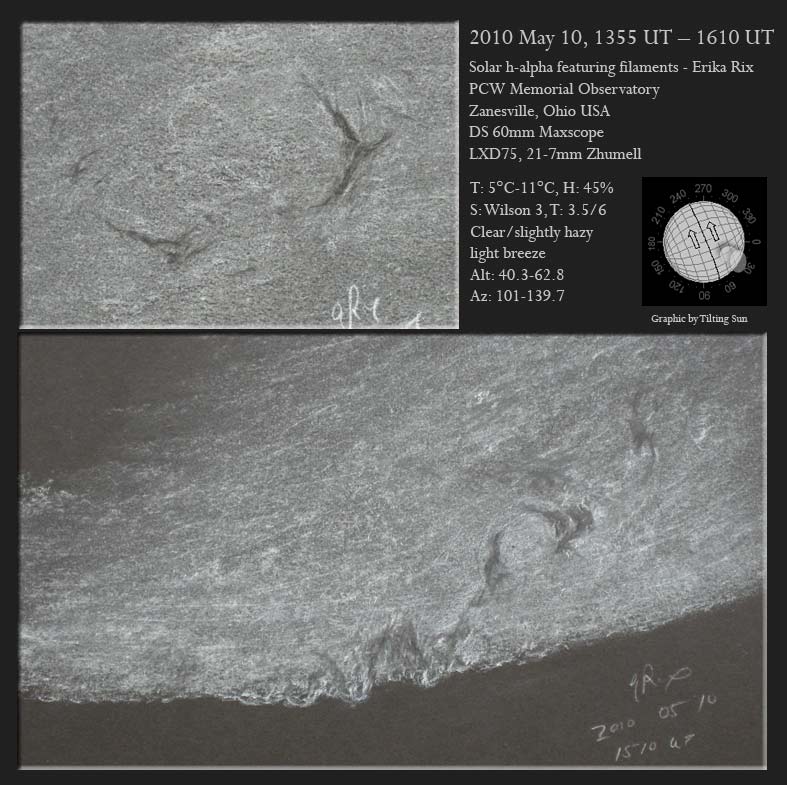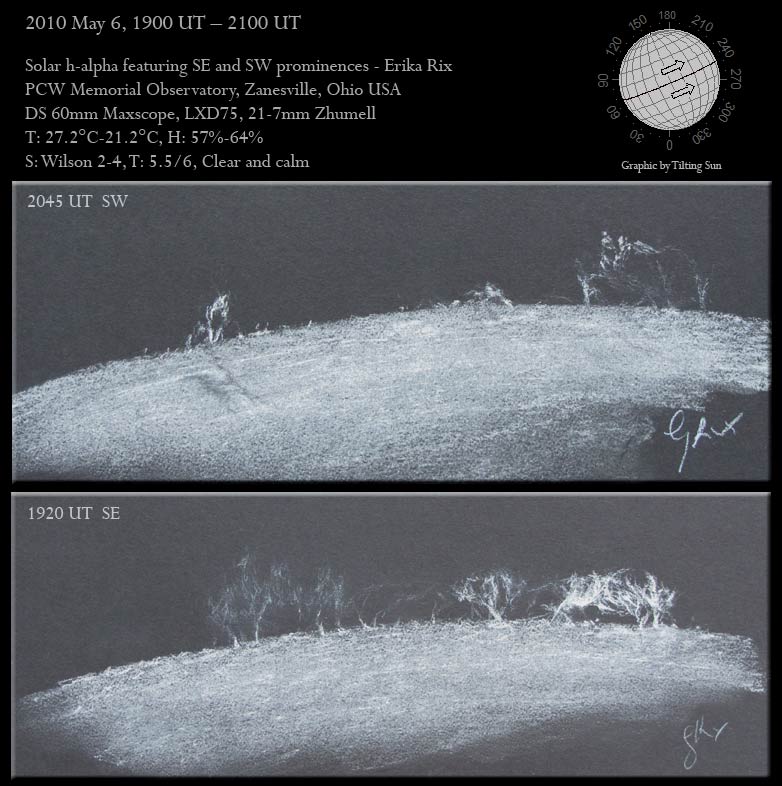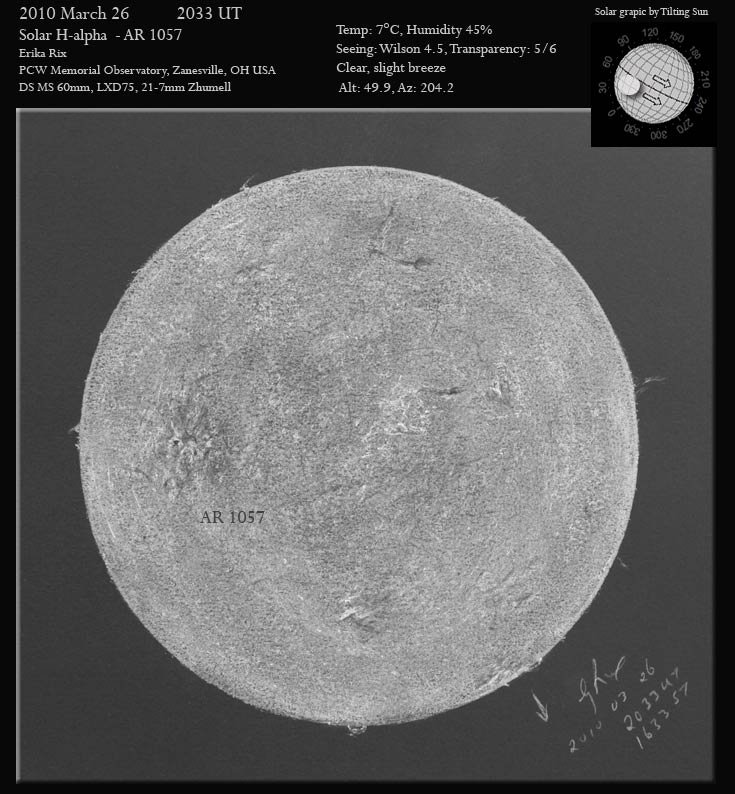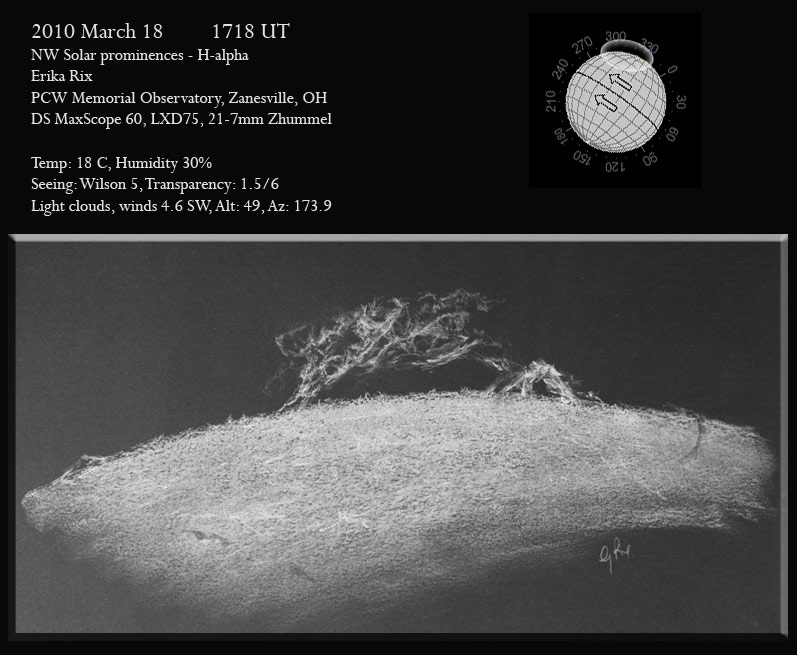Aloha,
I would like to submit a picture.
My name is Thia Krach
I live on Maui in Hawaii
Media soft charcoal pencil created 5/12/11
Thank you for your consideration!
Charcoal pencil
2011 05 09, 1429UT-1550UT
Solar NOAA 11203, 11204, ??, 11209, 11208
www.pcwobservatory.com
PCW Memorial Observatory, Zanesville, Ohio USA – Erika Rix
DS 60mm Maxscope, LXD75, 21-7mm Zhumell, ETX70 AT w/tilt plate and white light glass filter.
All sketches done scopeside and flipped in Photoshop to match standard orientation. H-alpha sketch created with black Strathmore Artagain paper, white Conte’ crayon and pencil, Derwent charcoal pencil, black oil pencil. White light sketch created on photocopy paper with 0.5mm mechanical pencil and #2 pencil.
Transparency made it nearly impossible to view prominences at the start of the session with the thin layer of cirrus creating a milky white sky. There were small breaks that allowed me to sketch in some of the detail on a western prominence, that later as the transparency improved, showed an abundance of thin whispy structure that wasn’t captured on paper. By that time, I was already working on a full disk sketch in h-alpha. Seeing was terrific until I started on the white light observation, but had I set up the ETX at the beginning of the session to let the scope adjust to the warmth, it would have been much better by the time I observed with it. As it was, I observed in the observatory for protection of the wind as I view with a shade attached to the objective and wanted to avoid vibration.
There is a possible new active region between 1209 and 1208 that, while observing in white light, had several little spots forming an elliptical shape with pointed ends like a football. I noticed facula around 1208, but the seeing was so bad that I couldn’t make out a definite shape. The umbra of the preceding spot in that region was displaced, as was the preceding spot in 1203. I didn’t notice any sunspots in 1209 during my observation, but that may have been the result of the seeing.
The band of active regions is still putting on a nice show in h-alpha with more-defined plage around them.
2011 05 05, 1230 UT – 1515 UT
Solar h-alpha, NOAAs 11203, 11204, 11205, 11207 and prominences
PCW Memorial Observatory, Zanesville, Ohio USA – Erika Rix, www.pcwobservatory.com
Temp: 22.5°C, Humidity 38%
Seeing: Wilson 4, Transparency: 3/6
DS 60mm Maxscope, LXD75, 21-7mm Zhumell, ETX70 AT w/tilt plate and white light glass filter.
H-alpha sketch created scopeside with black Strathmore Artagain paper, white Conte’ crayon and pencil, Derwent charcoal pencil, black oil pencil. White light sketch created on photocopy paper with 0.5mm mechanical pencil and #2 pencil.
The Sun was a little too low in the observatory for me to stay inside at the beginning of the session, so I pulled all my gear onto the grass. It was probably the best move anyway, since it warmed up quite a bit during the session.
I started off with the Maxscope for an overall view. The prominence at the western limb caught my eye initially, but it was the prominence on the eastern limb that really put on a show. It was nearly three times taller than the other and had the faintest wisps of filament reaching out connecting the brightest three areas of that prominence section.
The h-alpha full disk was filled with filaments and plage within the band of active regions. I’ve flipped the views of both the white light and h-alpha full disk sketches to match the standard view (at least a little more so as I didn’t rotate it completely) for comparisons with SOHO views. In white light, there were three distinct areas of faculae, one each on the western and eastern limbs and one around AR 11207. I couldn’t detect 1205 in white light and although the Sun had rotated slightly, I’m fairly sure 1207 is indeed that designation in my sketch and not 1205. Prenumbrae were noted around the preceding spots in 1204 and around the entirety of 1203.
Object : Meteor Shower from 3200 Phaeton(Geminids)
Date : December 13/14 2010
Time : 03:15-04:15 LST / 10:15-11:15 UT
Location : Wickenburg, Arizona USA
Medium : Charcoal pencils, white paper, paintbrush used as stump, Windows Paint for inversion, polishing and removing unwanted artifacts
Detector : Visual observation
Magnitude : Varying from 5 to -2
Weather : Moonless sky, Wispy cirrus clouds that soon dissipated, calm winds,somewhat chilly in the mid 40’s
Comments :
The Geminids for this season didn’t dissapoint ! As you can see, in my opinion, it surpassed the Zenithal Hourly Rate (ZHR) from that of this past August’s Perseids. In this one hour time frame sketch, I jotted down over 80 blazing streaks of the falling particles. Obviously, this didn’t include those that fell behind me or the ones that went unnoticed. It easily matched the confirmed rate of 120 (ZHR) or even more !!
In the sketch, I tried to cover a vast area of sky to show not only the radiant and its host constellation but also where the ‘shooting stars’ will be falling. In most cases they appear to fall a good distance away from the radiant. I chose the area with Canis Major,Orion,Taurus, Auriga, M44, M45 and high above is of course Gemini. While most of the meteors burned brightly white/yellow-or so they appeared, there was one that I caught high over my head with a yellow/green color! This meteor had a ‘double streak’ !!
I could distinctly see two greenish trails with a gap in between as it vaporized across the sky. A rather peculiar sight to witness, perhaps some of you out there have seen them too.
Well, it sure was worthed watching this shower all the way into the dawn hours and leaving me a happy camper. 😉
Wishing you dark and clear skies,
Juanchin
Mars
Planet
Malta (35.52N; 14.26E) at www.znith-observatory.blogspot.com
October 2009-May 2010
Graphite pencil, charcoal, white paper, scanner
This 2009-2010 Mars map is a collage of sketches made through my telescope (SCT 200mm, and colour filters) which spanned from October 2009 till May 2010. Mars offers the best telescopic views at opposition. Large surface markings offer interesting analysis and comparison with similar maps produced by astro-imagers using camears instead of their eyes. As often seen through an astronomical telescope eyepiece, the planet’s orientation is inverted, with Mars’ north polar cap at the bottom.
For a full detailed 2009-2010 Mars Apparition report, including visual observations and sketches made, I invite readers to CLICK HERE.
Charles Galdies

H-Alpha Sun and Filaments – May 10, 2010
By Erika Rix
2010 May 10, 1355 UT – 1610 UT
Solar h-alpha featuring filaments – Erika Rix
PCW Memorial Observatory, Zanesville, Ohio USA
DS 60mm Maxscope, LXD75, 21-7mm Zhumell
H-alpha sketch created scopeside with black Strathmore paper, white Conte’ crayon and pencil, white Prang watercolor pencil, Derwent charcoal pencil, black oil pencil.
T: 5°C-11°C, H: 45%
S: Wilson 3, T: 3.5/6
Clear/slightly hazy, light breeze
Alt: 40.3-62.8, Az: 101-139.7
Paul had a late night imaging so I brought the dogs outside with me, puppies included, to keep it quiet in the house for him. This, of course, meant lots of extra paws running around the observatory floor instead of just the steady snoring of Riser, my regular observing buddy. The views were shaking so badly that I finally gave up and tore down the rig, resetting it back up in the grass. I should have done that to begin with I suppose since seeing wasn’t the greatest and would have been a lot worse in the observatory, especially with the temps rising so quickly after our freeze last night.
There were quite a few features to concentrate on, but what really caught my eye were two areas of filaments in the NE quadrant. The transparency and seeing were just poor enough that I really struggled with pulling any detail out of the prominences on that section of the limb. I didn’t want to miss out trying to capture them as they reached inward across the disk, forming a beautiful display of soft looking filaments. Then even further inward reaching toward the center, the details were sharper with the next set of filaments.

Solar Prominences – May 6, 2010
Sketch and Details by Erika Rix
2010 May 6, 1900 UT – 2100 UT
Solar h-alpha featuring SE and SW prominences – Erika Rix
PCW Memorial Observatory, Zanesville, Ohio USA
DS 60mm Maxscope, LXD75, 21-7mm Zhumell
H-alpha sketch created scopeside with black Strathmore paper, white Conte’ crayon and pencil, white Prang watercolor pencil, Derwent charcoal pencil, black oil pencil.
T: 27.2°C-21.2°C, H: 57%-64%
S: Wilson 2-4, T: 5.5/6
Clear and calm
Alt: 58.5-37.8, Az: 229.2-259.9
I set up outside of the observatory today since the Sun was moving over the SW tree line and I didn’t want to rush my observing session. I had planned on putting in the cold crops in the garden but just couldn’t resist observing instead.
The active regions and filaments were tempting, but it had been so long since I’ve done close up prominence studies that I decided to concentrate on two limb areas instead. At the beginning of the session, the SW had a larger prominence that looked like a comma hovering over a crooked finger. I decided to move to the SE limb instead because what appeared to be a very bright hedgerow prominence with a smaller prominence beside it, turned out to a very wide set of prominences connected together, with over half of it so faint it was difficult to tease the detail out with the poorer seeing conditions at the beginning of the session.
Seeing gradually improved and I decided to go for a second sketch and just couldn’t help nabbing that comma prominence. It had already changed its shape to where it was no longer a comma, but a large loop instead. I was only able to make out the faintest portion of the loop with my Sol-Survivor cover completely shut around my head and eyepiece.

Solar H-Alpha – AR11057
Sketch and Details by Erika Rix
*2010 March 26, 2033 UT.
Solar h-alpha, AR11057.
PCW Memorial Observatory, Zanesville, Ohio USA – Erika Rix.
DS 60mm Maxscope, LXD75, 21-7mm Zhumell.
H-alpha sketch created scopeside with black Canson paper, white Conte’ crayon and pencil, white Prang watercolor pencil, Derwent charcoal pencil, black oil pencil.
SW prominence at first glance looked detached. Increasing mag and waiting for steady seeing, I could make out fainter portions of the prominence that reached the limb. There were a few brighter prominence regions scattered about, but nothing of great significance, especially after the magnificent NW prominence last week.
AR 11057 stood out immediately with two dark areas and bright plage. Panning the FOV brought out another bright plage area on the WNW area just 10 deg in from limb. This could possibly be a remnant of 11056. Toward the southern-middle of the disk, brighter little clusters of plage scattered the area, as well a plage to the NW about 40 deg in from the limb. There were a few filaments but the one that really caught my eye was a wide V-shaped one to the SE. I had to tweak the Etalons to bring out the full structure of what first appeared as a single line of filament.

Solar h-alpha, Active regions 1054, 1056
Sketch and Details by Erika Rix
DS 60mm Maxscope, LXD75, 21-7mm Zhumell
H-alpha sketch created scope-side with black Canson paper, white Conte’ crayon and pencil, white Prang watercolor pencil, Derwent charcoal pencil, black oil pencil.
That huge prom was an absolute beauty and I could have spent the entire day sketching it over and over for an animation. As it was, it nearly was so complex that a person could spend too much time on one sketch and end up chasing the changes and never actually complete the sketch.
Messier 66
Sketch and Details by Dale Holt
Hover cursor over image to view the original negative sketch.
On the evening of Monday 15th I had meant to go after more elusive prey but as my telescope GOTO isn’t very accurate and I therefore I need to star hop from the park position to my quarry I couldn’t help but stop off at M66 (as I was passing that way 🙂 to see how it looked with the 20″ & Watec 120N camera.
The view was stunning so there I stopped & sketched, the sky deteriorated quickly dropping to around mag 2 by the time I had completed my sketch. I took a look at nearby NGC2628, impressive & huge it stretched the full width of my b&w monitor plus a little more and resembled an old ‘British Rail’ sandwich with the upper slice curling up and exposing the filling at each end 🙂 no sketch I knew the poor sky outside was hiding much detail so I will need to return on a clearer evening.
Warm regards, Dale
Telescope: 505mm F3.7 Newtonian
Watec 120N video camera + 0.5x focal reducer giving real time image on 14″ b&w TV monitor.
Sketch made with graphite pencil & charcoal onto white paper, blending stumps used. Drawing scanned & Inverted
Location Chippingdale Observatory, NE Hertfordshire, UK
Observer Dale Holt